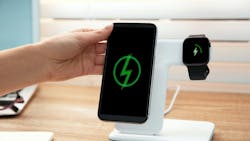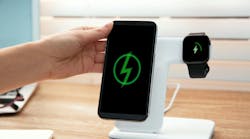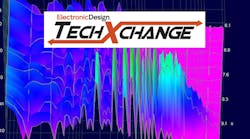Addressing EMI Issues Plaguing Wireless Power Transfer
What you'll learn:
- What is wireless power transfer (WPT)?
- Why minimizing EMI in WPT applications is important.
Electromagnetic fields (EMFs) are made up of both electric fields and magnetic fields. Electromagnetic interference (EMI) is caused by the interaction of EMF in applications like wireless power transfer (WPT) systems.
Wireless power transfer is used to charge everything from smartphones to smart watches. WPT standards have been around for a while and the latest technology has improved power efficiency and high power levels. The Wireless Power Consortium’s Qi standard utilizes inductive charging.
EMF Challenges Using Wireless Power Transfer
WPT systems have difficulties with EMF leakage that may lead to EMI issues within the human body. For example, cochlear implants can be powered by a WPT system.
An additional shielding coil can suppress EMF emanating from that WPT system.1 The approach, which is able to reduce the EMF leakage by 5.1 dB, was developed using 3D electromagnetic simulation. The EMF shielding is implemented using a matching capacitance control system.
They were able to determine the optimal phase difference between wireless transmitter and receiver coils to suppress a leakage magnetic field within WPT systems. As the power level of the WPT system increased without the feature, so did the leakage in the magnetic field, which can affect humans. This effect is usually an EMF problem within the WPT technology field.
Download the PDF of this article, and check out the TechXchange for similar articles and videos
Many existing shielding methods may reduce a leakage magnetic field. However, all of these methods need additional power sources or materials. The proposed method suppresses the leakage magnetic field by determining the difference in phase between TX and RX coil current with no additional materials. It reduces the weight and cost of the WPT system.
The leakage magnetic field may be minimized without employing any other methodology, e.g., using magnetic, metallic, reactive, or reactive shields. Various parameters like operating frequency and number of turns were scrutinized and ultimately the maximum shielding performance reached 48.7 %.2
WPT Power Transmission
Power is transmitted in WPT systems via magnetic coupling between transmitting (TX) and receiving (RX) coils in accordance with Faraday’s law. This method uses the magnetic field that’s generated by the coil, leading to the leakage of EMFs.
To transmit power with high efficiency, many active elements in the WPT system will switch at high speeds. Subsequently, EMI problems will occur at frequencies higher than the operating frequency. The leakage EMFs and EMI will negatively affect the human body or even other kinds of electronic devices, which progressively raises safety concerns in WPT systems.3
References
1. “Low EMF Design of Cochlear Implant Wireless Power Transfer System using A Shielding Coil,” Seokwoo Hong, Seungtaek Jeong, Seongsoo Lee, Boogyo Sim, Hongseok Kim and Joungho Kim, IEEE 2020.
2. “Determination of Optimal Current Phase Difference between Transmitter and Receiver Coils for Minimizing Leakage Magnetic Field in Wireless Power Transfer Systems,” Seongho Woo, Yujin Shin, Sungryul Huh, Hyunsoo Lee, Seungyoung Ahn, 2024 IEEE International Symposium on Electromagnetic Compatibility, Signal & Power Integrity (EMC+SIPI), IEEE 2024.
3. “Recent Advances in Safety Technologies for Wireless Power Transfer Applications,” Sungryul Huh, Seongho Woo, Haerim Kim, Hyunsoo Lee, Youbin Jun, Seungyoung Ahn, Wireless Power Technology, Conference and Expo (WPTCE), IEEE 2024.
Download the PDF of this article, and check out the TechXchange for similar articles and videos
About the Author

Steve Taranovich
Freelance Technical Writer, Phoenix Information Communication LLC
Steve is a contributing editor to Electronic Design.
Author of the non-fiction “Guardians of the Right Stuff,” a true story of the Apollo program as told by NASA and Grumman Corp. engineers, an astronaut, and technicians.
Experienced Editor-In-Chief of EETimes/Planet Analog and Senior Technical Editor at EDN running the Analog and Power Management Design Centers from 2012 to 2019.
A demonstrated history in electronic circuit design and applications for 40 years, and nine years of technical writing and editing in industry. Skilled in Analog Electronics, Space-related Electronics, Audio, RF & Communications, Power Management, Electrical Engineering, and Integrated Circuits (IC).
1972 to 1988 worked as a circuit design engineer in audio (8 years) and microwave (8 years). Then was Corporate Account Manager/applications engineer for Burr-Brown from 1988 to 2000 when TI purchased Burr-Brown. Worked for TI from 2000 to 2011.
Strong media and communication professional with a BEEE from NYU Engineering in 1972 and an MSEE from Polytechnic University in 1989. Senior Lifetime member of IEEE. Former IEEE Long Island, NY Director of Educational Activities. Eta Kappa Nu EE honor society member since 1970.


